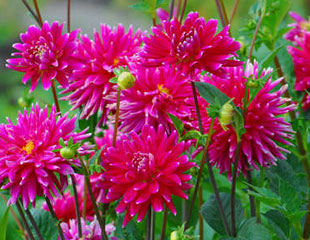
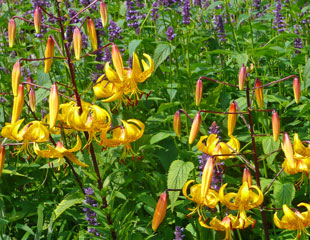
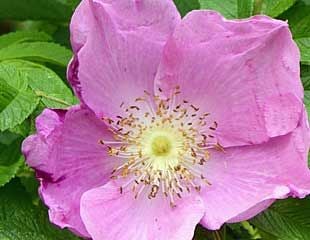
What to do in the garden in August
The last true month of summer and the garden and veg plot are still at their best. There is time to sow quick growing salad crops such as Lettuce, Rocket and radish. Dead heading flowers are essential to prolong flowering well into September as the later flowers come to their peak.
10 Best tips for looking after the garden while you are away holiday tips and ideas.
Need some ideas for August colour and planting- Check out shrubs and plants flowering in August.
Summer prune Wisteria
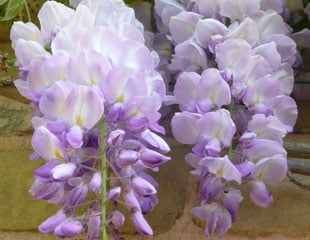
To get Wisteria to flower every year, a regime of regular pruning is essential. In summer (August) and winter ( Feb) See below for video tips on how to summer prune Wisteria.
August is a good time to prune Shrubs, which have flowered earlier in the season. Time to shape the shrub, encourage growth and blooms for next year and to cut back if the shrub is too large for the allotted space. In August, you can prune Rhododendron, Camellia, Ceanothus ( but not the autumn flowering variety,) Philadelphus, Choisya, Forsythia, Lilac, Pyracantha, and Wisteria.
Late July/August is the best time to give Wisteria its essential second prune. I often delay until later in August to enjoy the second flush of flowers, which, although less that the spring flowering, is still a welcome sight.
When pruning mature shrubs, the cuttings can make good plant stakes, and for free.
Pruning Wisteria correctly and learning more about pruning and how to grow Wisteria are essential to ensure that it flowers. Although a magnificent climber, growing Wisteria is not straightforward.
If you are interested in growing Wisteria on the YouTube Sunday Gardener channel there are videos on winter and summer pruning Wisteria, how to make Wisteria flower and a short video showing Wisteria in full bloom.
Black spot on Roses
As the summer goes on, Roses become more prone to black spot. Black spot will make the leaves turn yellow and spots appear, some leaves will fall to the ground. This is the ideal time to clear up the diseased leaves and destroy (not in the compost bin) and spray.
I do avoid using sprays in the garden, but regular spraying of the roses with a good spray such as 'Roseclear' really does work and the Roses are healthier. The current product Roseclear controls the key diseases on roses such as rose blackspot, powdery mildew and rust. It also protects plants from further infestations of aphids and diseases. With the earlier versions of this product, it was necessary to every week or two. It is now recommended spraying interval is 3 - 4 weeks between applications. I don't have shares in the manufacture of Roseclear, although it sounds as if I do, but it does the job.
I don't have shares in Uncle Tom's Rose Tonic either. It's very good. I have brought roses back from the brink with a few applications. Immediately, the rose perked up with signs of new growth. As this rose had been a present, I was keen to get it back on track. I buy this every year because it is good. Shop around this link is for illustrative purposes you can buy on Amazon and other sites.
Camellia and Rhododendrons
One reason Camellia and rhododendrons fail to flower in the spring can be a dry autumn. This time of year, Camellia and Rhododendrons are forming buds for next years' display. To ensure plenty of buds and flowers, if it is a dry autumn water well.
Trim and lightly prune Lavender
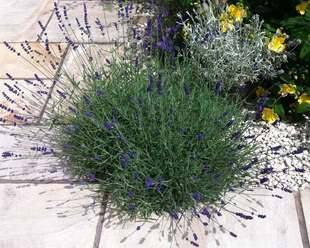
Late August after flowering is the best time to trim spent flowers from Lavender and clip the plant into neat shape as shown in the neatly trimmed Lavender image left. You can just cut off the spent stems and flowers. However, buy pruning the shrub back, taking off up yo 10cms, you will improve the shape of the plant and let air/light into the centre, encouraging more new growth in the spring.
Planting by a path is ideal, as Lavender will release scent on contact.Brushing past will produce the lovely Lavender perfume. This variety 'Hidcote' is one of the hardiest of the various Lavender varieties, which can be helpful, as Lavender detest cold wet winters. If you like the faded stems on Lavender, you can delay trimming it back until early spring.
Do not trim Lavender stoechas (French lavender) which flowers continuously, just dead head throughout the summer ideas with Lavender
Cut back tired looking foliage on Perennials
Even now it is not too late to cut back some Perennials which are looking faded, such as hardy geraniums, Nepeta (Cat Mint) Alchemilla (Lady's Mantle.) Cut back to tidy shape and when doing this you may notice, at the base and centre of the plant there is already new growth spurting. After cutting back, the plant may, or may not, flower again depending on the weather, but it will grow new foliage which will look fresh.
I have cut back Alchemilla almost to the ground in early July and by August the new growth has replaced the old and browning foliage. It will not flower again, but the foliage looks much better and fresher.
Some plants, such as Delphinium, may have very tired foliage and cutting them down may be the only option as the foliage becomes an eyesore.
This is also an ideal time to take cuttings from Pelargoniums and raise plants for free for next year. Easier than most plants to raise from cuttings for a guide on how to take cuttings.
Feed and Water next year's flowers
If you have time, ericaceous shrubs such as Camellias and Rhododendrons are forming their flower buds ready for next spring's display. A dry August can reduce the number and size of the buds, water well to avoid this. If you have not fed the ericaceous shrubs catch up by feeding in August and September using a proprietary ericaceous feed.
Prune hedges
Under Wildlife & Countryside Act 1981, it is an offence to intentionally damage, destroy or take the nest of any wild bird while it is in use or being built or to intentionally destroy an egg of any wild bird. This restricts the pruning of hedges during the bird breeding season, but by August it is generally considered that the birds have finished nesting and it is possible to prune hedges.
The Wildlife & Countryside Act 1981 does not prescribe dates but generally, the main bird breeding season is recognised as being between 1 March and 31 July, although it remains the householder's duty to check the hedge first, even outside the main season just to be sure
August in the Veg plot
Harvesting crops
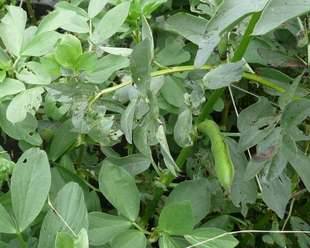
Many of the crops are ready to harvest during August and September, and it is a priority job to keep harvesting. Picking the veg, similarly to dead heading flowers, encourages continued fruiting and so a better yield. After all the hard work of growing the crop, to miss the moment when the beans, courgettes and salads are at their peak as veg quickly goes over and past its best.
It is possible to get a second crop of broad beans, especially if the summer is good. In late July/early August, when the broad bean plant has finished, cut down the stem close to the ground about 15 cm near a growing point and give it a feed.
In a good year it will regrow and produce a second, lighter smaller crop, but perfectly acceptable producing fresh broad beans in late summer/early autumn. Looking at the image left, you can see evidence of both old and new growth ( the new leaves are a paler colour,) on the broad bean plants, the new growth being produced after the bean has been cut down to aid a second crop; more advice on growing broad beans.
Drying and Storing Onions Garlic and Shallots
Depending on the aspect and geography of your veg plot, Onions, Garlic and Shallots should be ready to harvest by the end of the month,/early September. As soon as the top growth goes brown, bend over the top growth, which is said to aid ripening, and then pick a dry spell to ease the bulbs out of the earth carefully before resting them on soil to dry out before bringing in for storage. Onions need to be stored in the light.
Garlic is similar, wait till the top growth turns brown, usually in late August/Sept. Store in a dry and light spot in the warmth rather than a cold area.
After harvesting, you can leave onions and shallots on the ground to dry if there is a decent dry spell. With our variable weather, it's hard to find a dry spell, and so if the weather is wet, you will need to find another way to dry the onions. It is very important that when onions are put into storage that they are bone dry, if damp, they will rot and quickly become unusable .
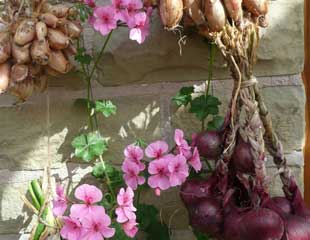
One way to dry off the onions is to bring them indoors, into a conservatory, greenhouse or under glass and dry off in the warm atmosphere. The greenhouse is ideal and you can dry them on the slatted shelves.
For both onions and garlic, once dried, their winter storage requirements are the same. Both onions and garlic have the same winter storage requirements once dried. You should keep them in a dry, well-ventilated place, either in a net to allow air circulation or platted and hung in a dry shed/garage/conservatory where they will look nice, as long as you don't mind the onion smell.
Onions and Garlic will store for 12 months in a suitably light dry environment, not the kitchen. An easy way is to lay onions and garlic out on the greenhouse slates to dry, check out growing onions for more information.
Tomato Care
There is plenty to do with ongoing tomato care, which is important as the plants are producing many tomatoes. Tomatoes also produce masses of leaves, and these need to be thinned out to encourage fruit production. The tomatoes have set several trusses of flowers by this stage and the top growing point needs to be pinched out to stop the plant growing any taller. The goal is to stop the planting growing and producing yet more leaves and to divert its energy into fruiting.
Even after pinching out the growing points because tomatoes grow vigorously if allowed, the plant will keep producing new top growth and you will need to keep on pinching out all top growth. The plant will keep growing, keep pinching out and removing leaves so all energy goes to the fruit.
This is the most important time for regular watering and feeding to ensure a good crop of sweet tasting tomatoes. Without the right amount of water and feeding, there will be tomatoes, but of poor quality. More about growing tomatoes.
Late summer is also a risky time for blight to appear. Read what you can do about blight and video advice.
Looking after the Veg plot.
There is still enough summer left to sow last rows of lettuces, rocket and crops such as Pak Choi which prefer cooler conditions and will be less prone to bolting (running to seed prematurely because growing conditions are too hot and dry) Any late crops sown during August will need cloche protection later when it becomes cooler. Also, time to thinking about growing winter lettuces.
Maincrop potatoes should be ready to be harvested in August/September It is essential that Maincrop potatoes are stored somewhere dry and dark that is 100% dry and light excluded.
Strawberries are all over now and so you can use the runners to make extra or new plants for next year. Let the runners develop and peg down into a pot adjacent to the plant so that when properly rooted in a few weeks, the runner can be cut away from the main plant. Strawberry plants need replacing about every 4 years as the yield gets less, so this is an easy way to get extra plants; more about growing strawberries.
